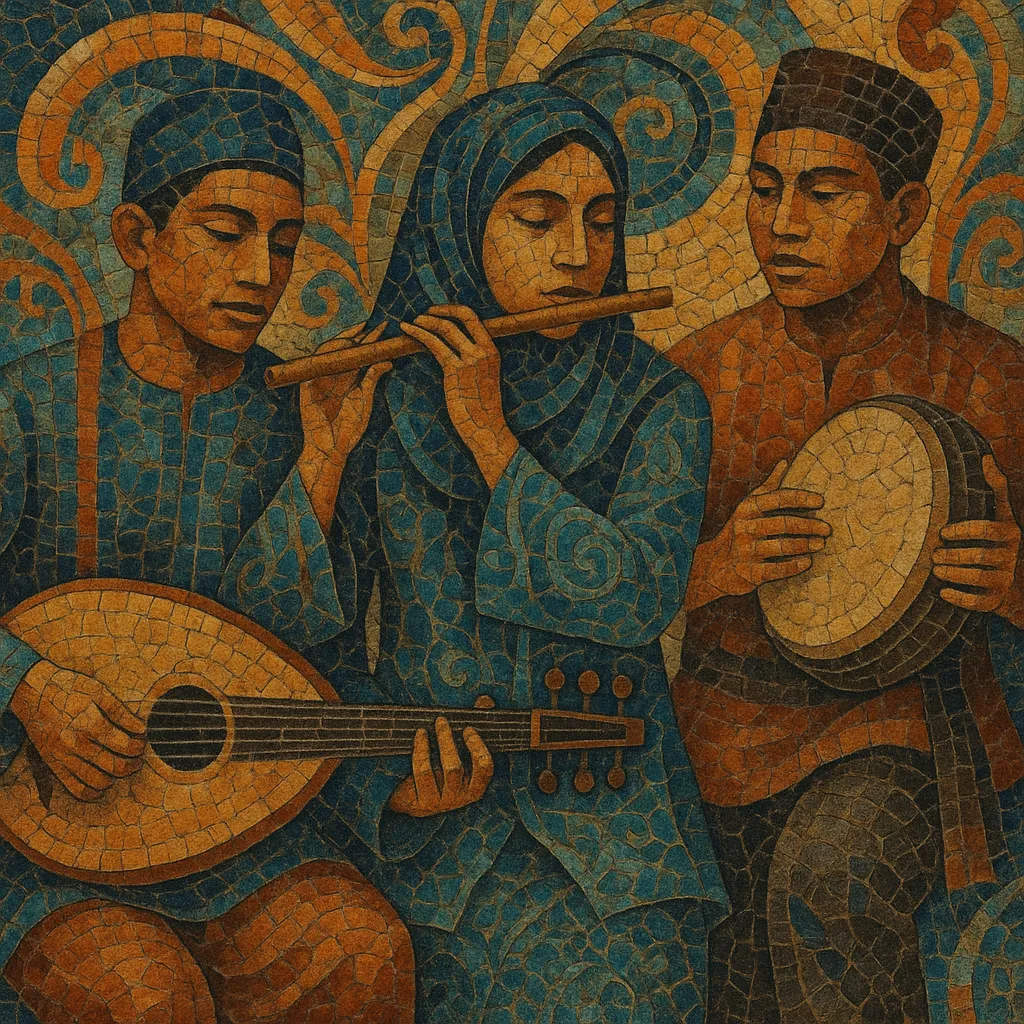Malay is a broad umbrella term for music created by and for the Malay-speaking world, centered in Malaysia and extending to Singapore, Brunei, and parts of Indonesia. It spans courtly and folk idioms (asli, inang, joget, zapin, dondang sayang, dikir barat, and Ghazal Johor) as well as modern popular styles performed in the Malay language.
Its sonic palette blends Arab-Islamic devotional aesthetics, North Indian (Hindustani) melodic sensibilities, Indonesian/Javanese gamelan colors, and traces of Portuguese colonial dance forms, later absorbing jazz, Latin, and Western pop. Common instruments include gambus (Arab lute), biola (violin), seruling (flute), harmonium or accordion, gendang and rebana/kompang frame drums, alongside modern guitar, keyboards, and drum set. Vocals emphasize melisma and poetic delivery, often setting pantun (quatrain) texts and romantic or moral themes.
Malay musical identity coalesced from court and coastal trading cultures around the Malay Peninsula. Arab-Islamic contacts brought devotional singing and frame drums, while Indian traders informed melodic ornamentation and poetic genres (notably ghazal). Portuguese presence in Melaka left dance-music imprints that feed joget and dondang sayang. Javanese influence introduced gamelan aesthetics, and local folk practices shaped asli, inang, and other song-dance forms.
With urban theater (bangsawan) and early shellac recordings in Singapore and Penang, Malay repertoire began circulating widely. Orkes Melayu ensembles—mixing gambus, violin, accordion/harmonium, and percussion—standardized accompaniments for asli, zapin, and romantic ballads. Keroncong’s presence in the region also crossed into Malay performance practice.
The Malay film industry (notably Shaw’s Malay Film Productions and Cathay-Keris in Singapore) propelled a star-driven song tradition. Figures like P. Ramlee and Saloma fused Malay melodic language with Latin/bolero, jazz harmonies, and light orchestration, defining an urbane “Malay song” style that became foundational for later pop.
Post-independence Malaysia saw state broadcasting and festivals nurture traditional forms (Ghazal Johor, dikir barat) while pop and rock in Malay flourished. The irama Malaysia movement blended traditional rhythms and scales with contemporary production. A parallel nasyid wave localized Islamic devotional pop, reflecting nasheed and qasidah modern influences.
Today, Malay remains a living umbrella across heritage ensembles and mainstream pop, R&B, hip hop, and rock. Artists draw on pantun lyricism, melisma, and traditional grooves (zapin/joget/inang) while using modern studio techniques. Cross-border exchange with Singapore, Brunei, and Indonesia keeps Malay music stylistically porous and innovative.
Embrace expressive vocals with gentle vibrato and melisma. Set lyrics to pantun-style quatrains (ABAB) or other classical Malay poetic forms, favoring romance, nostalgia, morality, and community themes.
Use heptatonic melodies with Hindustani- and Arab-influenced ornamentation (grace notes, slides) and occasional Hijaz/Phrygian-dominant color alongside pentatonic ideas. Harmonically, simple I–IV–V progressions suit asli and joget; add ii–V–I or borrowed iv for film-song or jazz-tinged pieces.
Combine traditional and modern timbres: gambus (or oud), biola (violin), seruling (flute), harmonium or accordion, gendang, rebana/kompang, plus guitar, bass, light drum kit, and warm pads/strings. Keep percussion crisp and supportive of dance steps; leave space for vocal ornamentation.
Start with a vocal-led intro or short instrumental motif (gambus/violin). Layer rhythm (kompang + gendang), then add bass and chordal support. Use call-and-response backing vocals in refrains. In modern productions, subtle reverb and plate/room ambiences flatter vocals; avoid excessive distortion to preserve clarity and lyric intelligibility.
Craft verses as pantun quatrains with metaphor (flora/fauna, seascapes, courtship). Keep choruses memorable and concise, often resolving to tonic to support communal singing.


